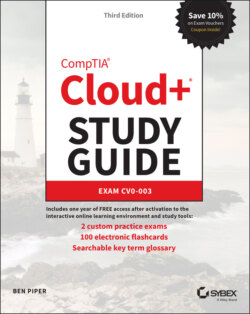| Exam Objective | Chapters |
| 5.1 Given a scenario, use the troubleshooting methodology to resolve cloud-related issues.Always consider corporate policies, procedures, and impacts before implementing changes. | 10 |
| Identify the problemQuestion the user and identify user changes to the computer and perform backups before making changesInquire regarding environmental or infrastructure changesEstablish a theory of probable cause (question the obvious)If necessary, conduct external or internal research based on symptomsTest the theory to determine causeOnce the theory is confirmed, determine the next steps to resolve the problemIf the theory is not confirmed, re-establish a new theory or escalateEstablish a plan of action to resolve the problem and implement the solutionVerify full system functionality and, if applicable, implement preventive measuresDocument the findings, actions, and outcomes throughout the process. | |
| 5.2 Given a scenario, troubleshoot security issues.PrivilegeMissingIncompleteEscalationKeysAuthenticationAuthorizationSecurity groupsNetwork security groupsDirectory security groupsKeys and certificatesExpiredRevokedTrustCompromisedMisconfiguredMisconfigured or misapplied policiesData security issuesUnencrypted dataData breachesMisclassificationLack of encryption in protocolsInsecure ciphersExposed endpointsMisconfigured or failedsecurity appliancesIPSIDSNACWAFUnsupported protocolsExternal/internal attacks | 10 |
| 5.3 Given a scenario, troubleshoot deployment issues.Connectivity issuesCloud service provider (CSP) or Internet service provider (ISP) outagesPerformance degradationLatencyConfigurationsScriptsApplications in containersMisconfigured templatesMissing or incorrect tagsInsufficient capacityScaling configurationsComputeStorageBandwidth issuesOversubscriptionLicensing issuesVendor-related issuesMigrations of vendors or platformsIntegration of vendors or platformsAPI request limitsCost or billing issues | 9 |
| 5.4 Given a scenario, troubleshoot connectivity issues.Network security group misconfigurationsACLInheritanceCommon networking configuration issuesPeeringIncorrect subnetIncorrect IP addressIncorrect IP spaceRoutesDefaultStaticDynamicFirewallIncorrectly administered micro-segmentationNetwork address translation (NAT)VPNSourceDestinationLoad balancersMethodsHeadersProtocolsEncryptionBack endsFront endsDNS recordsVLAN/VXLAN/GENEVEProxyMaximum transmission unit (MTU)Quality of service (QoS)Time synchronization issuesNetwork troubleshooting toolspingtracert/tracerouteflushdnsipconfig/ifconfig/ipnslookup/dignetstat/ssroutearpcurlPacket capturePacket analyzerOpenSSL client | 10 |
| 5.5 Given a scenario, troubleshoot common performance issues.Resource utilizationCPUGPUMemoryStorageI/OCapacityNetwork bandwidthNetwork latencyReplicationScalingApplicationMemory managementService overloadIncorrectly configured or failed load balancing | 9 |
| 5.6 Given a scenario, troubleshoot automation or orchestration issues.Account mismatchesChange management failuresServer name changesIP address changesLocation changesVersion/feature mismatchAutomation tool incompatibilityDeprecated featuresAPI version incompatibilityJob validation issuePatching failure | 9 |
